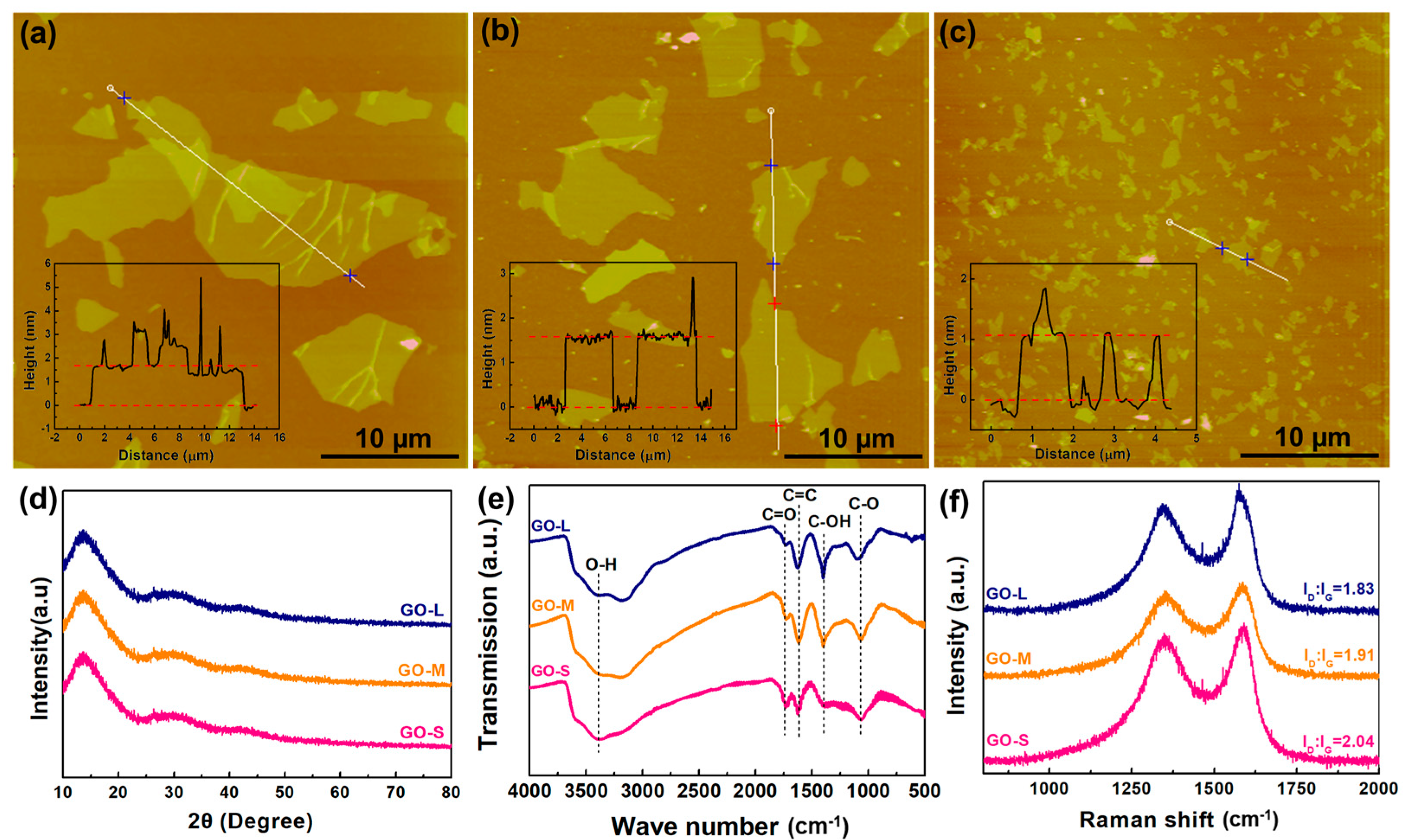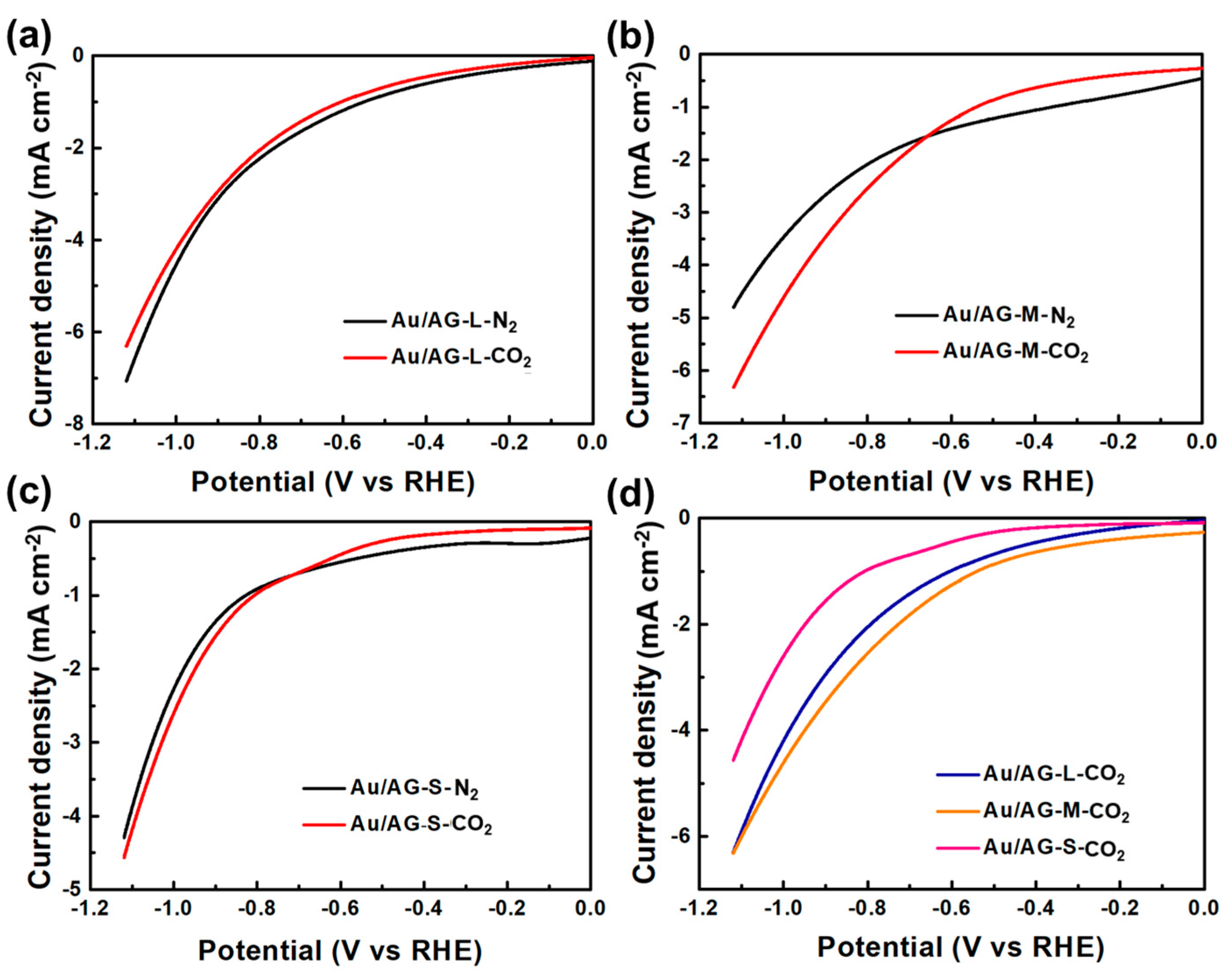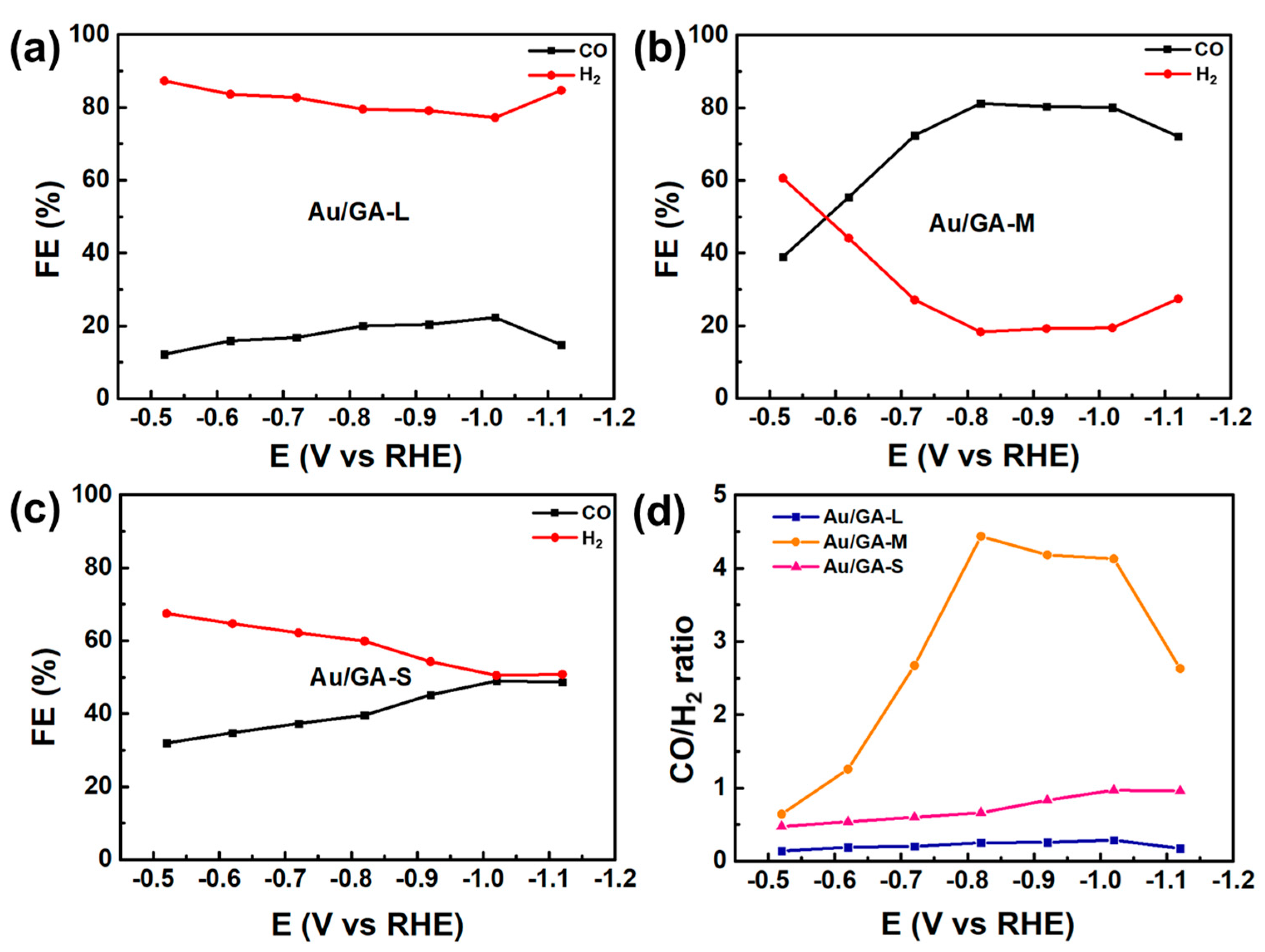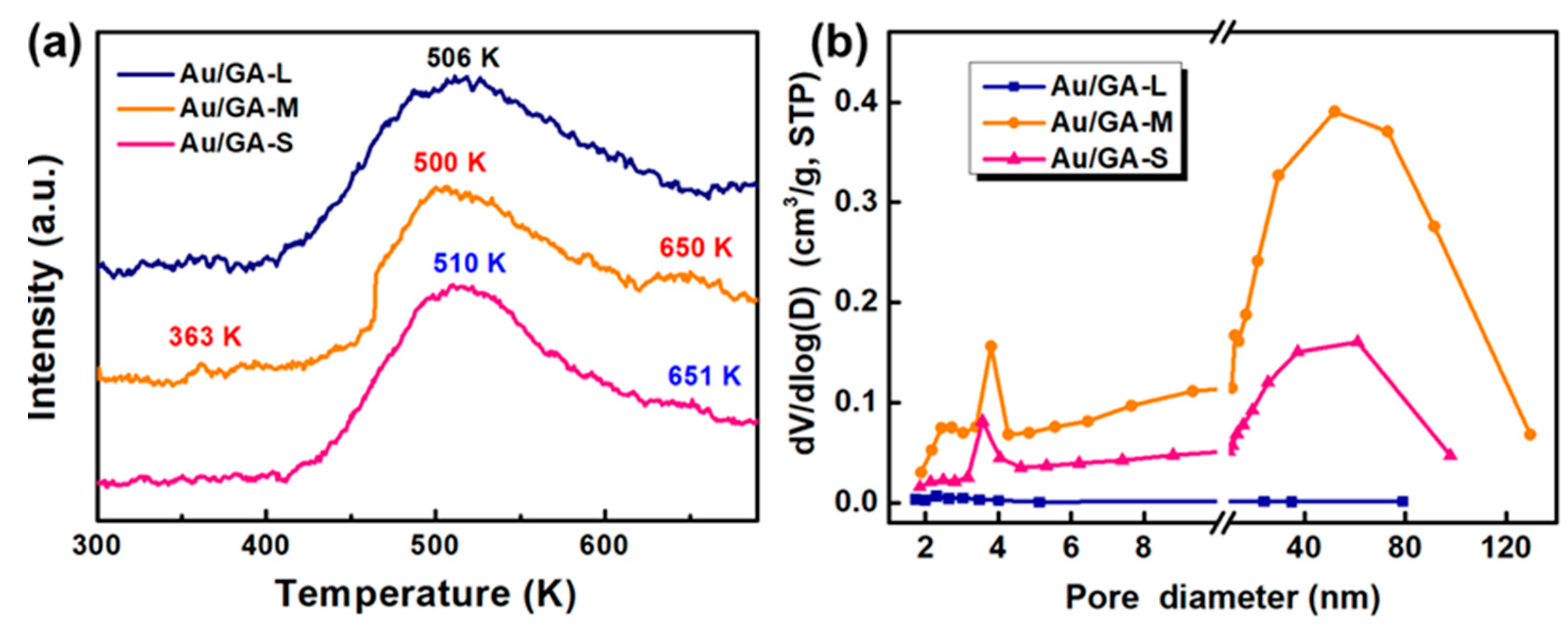Size Effect of Graphene Oxide on Graphene-Aerogel-Supported Au Catalysts for Electrochemical CO2 Reduction
Abstract
:1. Introduction
2. Materials and Methods
2.1. Chemicals
2.2. Preparation of GO-L
2.3. Preparation of Medium-Sized Graphene Oxide (GO-M)
2.4. Preparation of GO-S
2.5. Preparation of Au/GA
2.6. Characterization
2.7. Electrochemical Measurements
3. Results and Discussion
3.1. GO Precursors
3.2. Au/GA Nanocatalysts
3.3. CRR Performance
4. Conclusions
Supplementary Materials
Author Contributions
Funding
Institutional Review Board Statement
Informed Consent Statement
Data Availability Statement
Conflicts of Interest
References
- Geim, A.K.; Novoselov, K.S. The rise of graphene. Nat. Mater. 2007, 6, 183–191. [Google Scholar] [CrossRef] [PubMed]
- Wang, M.; Huang, M.; Luo, D.; Li, Y.; Choe, M.; Seong, W.K.; Kim, M.; Jin, S.; Wang, M.; Chatterjee, S.; et al. Single-crystal, large-area, fold-free monolayer graphene. Nature 2021, 596, 519–524. [Google Scholar] [CrossRef] [PubMed]
- Song, H.; Kang, F. Recent Progress on Thermal Conduction of Graphene. Acta Phys.-Chim. Sin. 2022, 38, 2101013. [Google Scholar] [CrossRef]
- Zhao, K.; Zhang, T.; Chang, H.; Yang, Y.; Xiao, P.; Zhang, H.; Li, C.; Tiwary, C.S.; Ajayan, P.M.; Chen, Y. Super-elasticity of three-dimensionally cross-linked graphene materials all the way to deep cryogenic temperatures. Sci. Adv. 2019, 5, eaav2589. [Google Scholar] [CrossRef]
- Qing, F.; Zhang, Y.; Niu, Y.; Stehle, R.; Chen, Y.; Li, X. Towards large-scale graphene transfer. Nanoscale 2020, 12, 10890–10911. [Google Scholar] [CrossRef]
- Hu, H.; Zhao, Z.; Wan, W.; Gogotsi, Y.; Qiu, J. Ultralight and Highly Compressible Graphene Aerogels. Adv. Mater. 2013, 25, 2219–2223. [Google Scholar] [CrossRef]
- Jing, J.; Qian, X.; Si, Y.; Liu, G.; Shi, C. Recent Advances in the Synthesis and Application of Three-Dimensional Graphene-Based Aerogels. Molecules 2022, 27, 924. [Google Scholar] [CrossRef] [PubMed]
- Cao, X.; Yin, Z.; Zhang, H. Three-dimensional graphene materials: Preparation, structures and application in supercapacitors. Energy Environ. Sci. 2014, 7, 1850–1865. [Google Scholar] [CrossRef]
- Li, Y.; Chen, N.; Li, Z.; Shao, H.; Sun, X.; Liu, F.; Liu, X.; Guo, Q.; Qu, L. Reborn Three-Dimensional Graphene with Ultrahigh Volumetric Desalination Capacity. Adv. Mater. 2021, 33, 2105853. [Google Scholar] [CrossRef]
- Zhou, J.; Wu, X.; Chen, Y.; Yang, C.; Yang, R.; Tan, J.; Liu, Y.; Qiu, L.; Cheng, H.-M. 3D Printed Template-Directed Assembly of Multiscale Graphene Structures. Adv. Funct. Mater. 2022, 32, 2105879. [Google Scholar] [CrossRef]
- Qiu, B.; Xing, M.; Zhang, J. Recent advances in three-dimensional graphene based materials for catalysis applications. Chem. Soc. Rev. 2018, 47, 2165–2216. [Google Scholar] [CrossRef]
- Cui, H.; Guo, Y.; Zhou, Z. Three-Dimensional Graphene-Based Macrostructures for Electrocatalysis. Small 2021, 17, 2005255. [Google Scholar] [CrossRef] [PubMed]
- Duan, J.; Chen, S.; Jaroniec, M.; Qiao, S.Z. Heteroatom-Doped Graphene-Based Materials for Energy-Relevant Electrocatalytic Processes. ACS Catal. 2015, 5, 5207–5234. [Google Scholar] [CrossRef]
- Hu, C.; Han, Q.; Zhao, F.; Yuan, Z.; Chen, N.; Qu, L. Graphitic C3N4-Pt nanohybrids supported on a graphene network for highly efficient methanol oxidation. Sci. China Mater. 2015, 58, 21–27. [Google Scholar] [CrossRef]
- Sun, Z.; Fang, S.; Hu, Y.H. 3D Graphene Materials: From Understanding to Design and Synthesis Control. Chem. Rev. 2020, 120, 10336–10453. [Google Scholar] [CrossRef] [PubMed]
- Han, J.; Johnson, I.; Chen, M. 3D Continuously Porous Graphene for Energy Applications. Adv. Mater. 2022, 34, 2108750. [Google Scholar] [CrossRef]
- Li, G.; Huang, B.; Pan, Z.; Su, X.; Shao, Z.; An, L. Advances in three-dimensional graphene-based materials: Configurations, preparation and application in secondary metal (Li, Na, K, Mg, Al)-ion batteries. Energy Environ. Sci. 2019, 12, 2030–2053. [Google Scholar] [CrossRef]
- Sun, H.; Mei, L.; Liang, J.; Zhao, Z.; Lee, C.; Fei, H.; Ding, M.; Lau, J.; Li, M.; Wang, C.; et al. Three-dimensional holey-graphene/niobia composite architectures for ultrahigh-rate energy storage. Science 2017, 356, 599–604. [Google Scholar] [CrossRef] [PubMed]
- Pan, F.; Chen, S.-M.; Li, Y.; Tao, Z.; Ye, J.; Ni, K.; Yu, H.; Xiang, B.; Ren, Y.; Qin, F.; et al. 3D Graphene Films Enable Simultaneously High Sensitivity and Large Stretchability for Strain Sensors. Adv. Funct. Mater. 2018, 28, 1803221. [Google Scholar] [CrossRef]
- Jayanthi, S.; Mukherjee, A.; Chatterjee, K.; Sood, A.K.; Misra, A. Tailored nitrogen dioxide sensing response of three-dimensional graphene foam. Sens. Actuators B Chem. 2016, 222, 21–27. [Google Scholar] [CrossRef]
- Ghosal, K.; Sarkar, K. Biomedical Applications of Graphene Nanomaterials and Beyond. ACS Biomater. Sci. Eng. 2018, 4, 2653–2703. [Google Scholar] [CrossRef] [PubMed]
- Amani, H.; Mostafavi, E.; Arzaghi, H.; Davaran, S.; Akbarzadeh, A.; Akhavan, O.; Pazoki-Toroudi, H.; Webster, T.J. Three-Dimensional Graphene Foams: Synthesis, Properties, Biocompatibility, Biodegradability, and Applications in Tissue Engineering. ACS Biomater. Sci. Eng. 2019, 5, 193–214. [Google Scholar] [CrossRef]
- Xia, Y.; Li, R.; Chen, R.; Wang, J.; Xiang, L. 3D Architectured Graphene/Metal Oxide Hybrids for Gas Sensors: A Review. Sensors 2018, 18, 1456. [Google Scholar] [CrossRef] [PubMed]
- Perreault, F.; de Faria, A.F.; Elimelech, M. Environmental applications of graphene-based nanomaterials. Chem. Soc. Rev. 2015, 44, 5861–5896. [Google Scholar] [CrossRef] [PubMed]
- Gao, Y.-F.; Wang, Y.; Zhou, D.; Lv, W.; Kang, F.-Y. Permselective graphene-based membranes and their applications in seawater desalination. New Carbon Mater. 2022, 37, 625–640. [Google Scholar] [CrossRef]
- Yousefi, N.; Lu, X.; Elimelech, M.; Tufenkji, N. Environmental performance of graphene-based 3D macrostructures. Nat. Nanotechnol. 2019, 14, 107–119. [Google Scholar] [CrossRef]
- Noh, Y.; Kim, Y.; Lee, S.; Lim, E.J.; Kim, J.G.; Choi, S.M.; Seo, M.H.; Kim, W.B. Exploring the effects of the size of reduced graphene oxide nanosheets for Pt-catalyzed electrode reactions. Nanoscale 2015, 7, 9438–9442. [Google Scholar] [CrossRef]
- Shen, Y.; Zhu, X.; Chen, B. Size effects of graphene oxide nanosheets on the construction of three-dimensional graphene-based macrostructures as adsorbents. J. Mater. Chem. A 2016, 4, 12106–12118. [Google Scholar] [CrossRef]
- Costentin, C.; Robert, M.; Saveant, J.-M. Catalysis of the electrochemical reduction of carbon dioxide. Chem. Soc. Rev. 2013, 42, 2423–2436. [Google Scholar] [CrossRef]
- Nitopi, S.; Bertheussen, E.; Scott, S.B.; Liu, X.; Engstfeld, A.K.; Horch, S.; Seger, B.; Stephens, I.E.L.; Chan, K.; Hahn, C.; et al. Progress and Perspectives of Electrochemical CO2 Reduction on Copper in Aqueous Electrolyte. Chem. Rev. 2019, 119, 7610–7672. [Google Scholar] [CrossRef]
- Singh, G.; Lee, J.; Karakoti, A.; Bahadur, R.; Yi, J.; Zhao, D.; AlBahily, K.; Vinu, A. Emerging trends in porous materials for CO2 capture and conversion. Chem. Soc. Rev. 2020, 49, 4360–4404. [Google Scholar] [CrossRef] [PubMed]
- Wang, Y.; Han, P.; Lv, X.; Zhang, L.; Zheng, G. Defect and Interface Engineering for Aqueous Electrocatalytic CO2 Reduction. Joule 2018, 2, 2551–2582. [Google Scholar] [CrossRef]
- Woldu, A.R.; Huang, Z.; Zhao, P.; Hu, L.; Astruc, D. Electrochemical CO2 reduction (CO2RR) to multi-carbon products over copper-based catalysts. Coord. Chem. Rev. 2022, 454, 214340. [Google Scholar] [CrossRef]
- Jiang, K.; Siahrostami, S.; Zheng, T.; Hu, Y.; Hwang, S.; Stavitski, E.; Peng, Y.; Dynes, J.; Gangisetty, M.; Su, D.; et al. Isolated Ni single atoms in graphene nanosheets for high-performance CO2 reduction. Energy Environ. Sci. 2018, 11, 893–903. [Google Scholar] [CrossRef]
- Wu, J.; Liu, M.; Sharma, P.P.; Yadav, R.M.; Ma, L.; Yang, Y.; Zou, X.; Zhou, X.-D.; Vajtai, R.; Yakobson, B.I.; et al. Incorporation of Nitrogen Defects for Efficient Reduction of CO2 via Two-Electron Pathway on Three-Dimensional Graphene Foam. Nano Lett. 2016, 16, 466–470. [Google Scholar] [CrossRef] [PubMed]
- Wang, M.; Bike, Z.; Ding, J.; Xu, N.; Bernards, M.; He, Y.; Shi, Y. Three-Dimensional Nitrogen-Doped Graphene Aerogel-Supported MnO Nanoparticles as Efficient Electrocatalysts for CO2 Reduction to CO. ACS Sustain. Chem. Eng. 2020, 8, 4983–4994. [Google Scholar] [CrossRef]
- Shao, T.; Duan, D.; Liu, S.; Gao, C.; Ji, H.; Xiong, Y. Tuning the local electronic structure of a single-site Ni catalyst by co-doping a 3D graphene framework with B/N atoms toward enhanced CO2 electroreduction. Nanoscale 2022, 14, 833–841. [Google Scholar] [CrossRef] [PubMed]
- Choi, J.; Kim, J.; Wagner, P.; Gambhir, S.; Jalili, R.; Byun, S.; Sayyar, S.; Lee, Y.M.; MacFarlane, D.R.; Wallace, G.G.; et al. Energy efficient electrochemical reduction of CO2 to CO using a three-dimensional porphyrin/graphene hydrogel. Energy Environ. Sci. 2019, 12, 747–755. [Google Scholar] [CrossRef]
- Yan, T.; Pan, H.; Liu, Z.; Kang, P. Phase-Inversion Induced 3D Electrode for Direct Acidic Electroreduction CO2 to Formic acid. Small 2023, 19, 2207650. [Google Scholar] [CrossRef] [PubMed]
- Han, Z.; Tang, Z.; Li, P.; Yang, G.; Zheng, Q.; Yang, J. Ammonia solution strengthened three-dimensional macro-porous graphene aerogel. Nanoscale 2013, 5, 5462–5467. [Google Scholar] [CrossRef]
- Shen, S.; Wang, J.; Wu, Z.; Du, Z.; Tang, Z.; Yang, J. Graphene Quantum Dots with High Yield and High Quality Synthesized from Low Cost Precursor of Aphanitic Graphite. Nanomaterials 2020, 10, 375. [Google Scholar] [CrossRef] [PubMed]
- Xu, Y.; Sheng, K.; Li, C.; Shi, G. Self-Assembled Graphene Hydrogel via a One-Step Hydrothermal Process. ACS Nano 2010, 4, 4324–4330. [Google Scholar] [CrossRef] [PubMed]
- Tang, Z.; Shen, S.; Zhuang, J.; Wang, X. Noble-Metal-Promoted Three-Dimensional Macroassembly of Single-Layered Graphene Oxide. Angew. Chem. Int. Ed. 2010, 49, 4603–4607. [Google Scholar] [CrossRef] [PubMed]







| Samples | GO-L | GO-M | GO-S | Au/GA-L | Au/GA-M | Au/GA-S |
|---|---|---|---|---|---|---|
| ID:IG ratio | 1.83 | 1.91 | 2.04 | 1.78 | 1.63 | 1.80 |
| Samples | Au/GA-L | Au/GA-M | Au/GA-S |
|---|---|---|---|
| BET surface area (m²/g) | 15 | 98 | 45 |
| Pore volume (m3/g) | 0.01 | 0.37 | 0.17 |
Disclaimer/Publisher’s Note: The statements, opinions and data contained in all publications are solely those of the individual author(s) and contributor(s) and not of MDPI and/or the editor(s). MDPI and/or the editor(s) disclaim responsibility for any injury to people or property resulting from any ideas, methods, instructions or products referred to in the content. |
© 2023 by the authors. Licensee MDPI, Basel, Switzerland. This article is an open access article distributed under the terms and conditions of the Creative Commons Attribution (CC BY) license (https://creativecommons.org/licenses/by/4.0/).
Share and Cite
Shen, S.; Pan, X.; Wang, J.; Bao, T.; Liu, X.; Tang, Z.; Xiu, H.; Li, J. Size Effect of Graphene Oxide on Graphene-Aerogel-Supported Au Catalysts for Electrochemical CO2 Reduction. Materials 2023, 16, 7042. https://doi.org/10.3390/ma16217042
Shen S, Pan X, Wang J, Bao T, Liu X, Tang Z, Xiu H, Li J. Size Effect of Graphene Oxide on Graphene-Aerogel-Supported Au Catalysts for Electrochemical CO2 Reduction. Materials. 2023; 16(21):7042. https://doi.org/10.3390/ma16217042
Chicago/Turabian StyleShen, Shuling, Xuecong Pan, Jin Wang, Tongyu Bao, Xinjuan Liu, Zhihong Tang, Huixin Xiu, and Jing Li. 2023. "Size Effect of Graphene Oxide on Graphene-Aerogel-Supported Au Catalysts for Electrochemical CO2 Reduction" Materials 16, no. 21: 7042. https://doi.org/10.3390/ma16217042
APA StyleShen, S., Pan, X., Wang, J., Bao, T., Liu, X., Tang, Z., Xiu, H., & Li, J. (2023). Size Effect of Graphene Oxide on Graphene-Aerogel-Supported Au Catalysts for Electrochemical CO2 Reduction. Materials, 16(21), 7042. https://doi.org/10.3390/ma16217042





